| Share |  |
 | |||
Health Gain - Weight Loss - Part 5 - Powered by Protein
 The importance of protein in the human body cannot be overestimated. Without protein, the body would lack essential building blocks needed for the maintenance, repair and growth of tissue.
The importance of protein in the human body cannot be overestimated. Without protein, the body would lack essential building blocks needed for the maintenance, repair and growth of tissue.
Protein forms the basic structure of vital body components, such as bones, muscles, and organs, in addition to skin, hair, and nails. Enzymes, hormones, antibodies and neurotransmitters that carry out key bodily functions are primarily comprised of protein as well.
In order for protein to be utilized in the body, it must be broken down into its smallest components, amino acids. Eight of the twenty-plus amino acids that make up protein are considered “essential”, meaning they must be supplied by food since the body cannot produce them.
Since protein cannot be stored in the body, like fats and carbohydrates, it is especially important to consume good sources of it throughout the day. Eating protein with every meal or snack (along with the right balance of carbohydrates and fats) works to keep blood sugar and insulin levels in check, control appetite and provide a steady supply of strength and energy.
How Protein Boosts Metabolism
Protein plays a vital role in metabolism and weight. Because protein is so vital for lean muscle growth, it is the most essential of the three macronutrients for supporting a speedy, more efficient metabolism (the other two macronutients are fat and carbohydrates).  Anytime the body lacks adequate amounts of protein, it will begin to break down the protein in its own muscle tissue for energy. As I covered in Health Gain-Weight Loss – Part 2 this is the opposite of what you want happening if you desire to lose weight. Remember - when a person has more lean muscle mass, more calories are burned for energy and fewer calories are stored as fat.
Anytime the body lacks adequate amounts of protein, it will begin to break down the protein in its own muscle tissue for energy. As I covered in Health Gain-Weight Loss – Part 2 this is the opposite of what you want happening if you desire to lose weight. Remember - when a person has more lean muscle mass, more calories are burned for energy and fewer calories are stored as fat.
Keeping the body supplied with adequate protein also increases the rate of metabolism, due to the amount of energy expended when protein is burned. The proper digestion and processing of protein uses enormous amounts of energy. For every 500 calories eaten, protein burns 125 calories, whereas carbohydrates and fats burn only 30 calories per 500 calories eaten. People on higher protein diets also tend to have better body composition and sustain weight loss for longer periods of time.
Bring on the Glucagon
Eating protein stimulates the body to produce the hormone glucagon which releases stored body fat so it can be burned for energy. This is the primary reason that high protein diets work for a time in helping people to lose weight.
Last month we talked about the chain reaction that takes place when a surge of insulin is released by the pancreas in response to high glucose levels in the bloodstream from eating sugar and refined carbohydrates. Too much insulin released at one time creates a drop in blood sugar that results in hunger and cravings. Glucagon helps stabilize blood sugar levels by releasing stored fuel back into the bloodstream to be used for energy.
Consuming a steady supply of protein in every meal and snack helps counterbalance the surge of insulin produced by consuming carbs. It is the best way to balance the “fat-storing” hormone (insulin) and the “fat-releasing” hormone (glucagon). Maintaining this balance prevents the body from either storing glucose in cells or converting it to fat. Moreover, it prevents a host of health problems brought on by “out of control” blood sugar levels.
Remember:
- Protein stimulates the production of glucagon
- Glucagon acts to stabilize blood sugar levels and release stored fat for use as energy
- Keeping blood sugar levels stable is key to weight control and health
Scientists have discovered other protein-produced hormones that affect appetite and weight control. 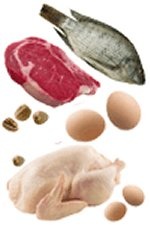 These hormones are known to act on receptors in the brain to reduce feelings of hunger and inhibit appetite, which accounts for the feeling of fullness people experience after consuming a protein-rich meal (the role of hormones associated with weight control will be the subject of a future article).
These hormones are known to act on receptors in the brain to reduce feelings of hunger and inhibit appetite, which accounts for the feeling of fullness people experience after consuming a protein-rich meal (the role of hormones associated with weight control will be the subject of a future article).
Sources of Meat Protein
Proteins from animal sources are the most complete, since they contain all of the amino acids needed to build muscle. This would include meat, poultry, fish, eggs and dairy. If you want to reap the maximum health benefits from these proteins while avoiding unnecessary harmful effects they may cause, it is best to obtain those that are produced as naturally as possible.
By all means, try to avoid highly processed “junk meats,” such as hot dogs, bologna, salami, sausage, and bacon. These forms of meat are not only high in unhealthy fats but they also are loaded with salt, nitrates, nitrites and other chemicals, some of which are clearly associated with the risk of certain cancers.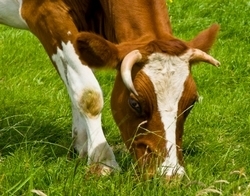 When it comes to beef, choose lean cuts of organically produced meat whenever possible. Most commercially produced beef is from grain-fed cattle rather than from cows that graze on grass as God designed them to do. They are fed large amounts of grain to fatten them up more quickly for greater financial profit, but the end result is beef that is much higher in saturated fats.
When it comes to beef, choose lean cuts of organically produced meat whenever possible. Most commercially produced beef is from grain-fed cattle rather than from cows that graze on grass as God designed them to do. They are fed large amounts of grain to fatten them up more quickly for greater financial profit, but the end result is beef that is much higher in saturated fats.
Feed given to cattle is typically comprised of grains higher in omega-6 fatty acids, whereas meat from grass-fed cows is significantly higher in omega-3 fatty acids (to better understand the health consequences of the over-consumption of omega-6 and the benefits of higher amounts of omega-3 in the diet, I would encourage you to read my article Understanding Fats – the Good, the Bad, and the BEST – Part 2).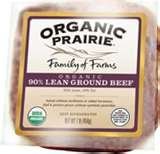
Another major problem with beef (as well as chicken and other poultry) not naturally produced is that they often receive hormones and antibiotics in their feed. This practice not only affects beef and chicken, but also the eggs from the chickens and all of the dairy products produced from the milk of the cows. Look for meat and dairy products which are organic or state that they are hormone- and antibiotic-free on the label.
Protein from Fish – Pros and Cons
Fish is a great source of quality protein, though not just any fish is a healthy option. Much caution must be exercised when purchasing fish, due to the amounts of toxic substances (especially mercury) that may be present in fish caught in contaminated waters. 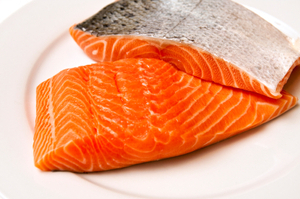 The healthiest fish are those caught wild in cold-water. These are uniformly high in omega-3 fatty acids. Farm-raised fish are not the best choice for a number of reasons. Because of disease and parasites, fish raised in feedlots are often subject to vaccinations, antibiotics and/or pesticides. Additionally, statistics provided by the FDA show that farm-raised fish are fattier, have a lower protein content and higher amounts of pro-inflammatory omega-6 fats than wild caught fish, which makes any omega-3 content of the fish less usable (for more information on this subject and specific guidelines related to fish consumption, I refer you to my article Understanding Fats, the Good, the Bad and the BEST – Part Two).
The healthiest fish are those caught wild in cold-water. These are uniformly high in omega-3 fatty acids. Farm-raised fish are not the best choice for a number of reasons. Because of disease and parasites, fish raised in feedlots are often subject to vaccinations, antibiotics and/or pesticides. Additionally, statistics provided by the FDA show that farm-raised fish are fattier, have a lower protein content and higher amounts of pro-inflammatory omega-6 fats than wild caught fish, which makes any omega-3 content of the fish less usable (for more information on this subject and specific guidelines related to fish consumption, I refer you to my article Understanding Fats, the Good, the Bad and the BEST – Part Two).
The Best Eggs
Eggs are a great source of protein and contain almost every essential vitamin and mineral the body needs to function. Eggs from pasture-raised free range chickens are higher in omega-3, have lower amounts of saturated fat and generally contain twice as much protein. One way to tell if an egg is truly “farm-raised” or “organic” is if the yoke has a deeper, more orange-yellow color as opposed to pale or normal yellow.
Although many people worry about eggs raising their cholesterol levels, more and more studies confirm that dietary cholesterol does not significantly increase blood cholesterol (80 percent of cholesterol is produced in the liver rather than obtained from dietary sources). The protein in overcooked eggs can be difficult to digest and lead to a food sensitivity reaction in some people.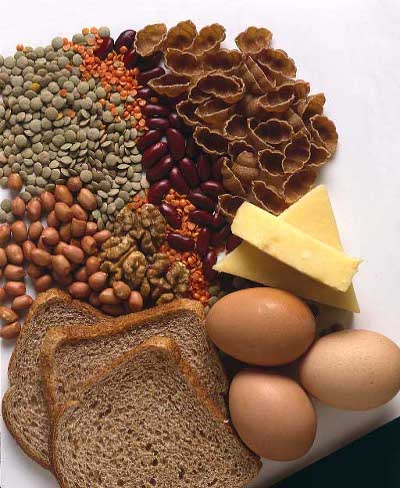
What About Plant Proteins?
Even though plant proteins do not contain all the essential amino acids necessary to make a complete protein as animal proteins do, plant proteins have the advantage of being higher in fiber and powerful phytonutrients and lower in saturated fat (plus they contain no cholesterol). The most abundant sources of plant proteins come from seeds, nuts, legumes and soy foods. Plant proteins may be low in one or more essential amino acids, but if properly combined, amino acids in one plant protein can compensate for the deficiencies of another. For instance, whole grains may be combined with legumes or nuts to make a complete protein. You can make numerous combinations, for instance: black beans and rice, pinto beans in a corn tortilla, whole-wheat toast with peanut butter, etc.
The most abundant sources of plant proteins come from seeds, nuts, legumes and soy foods. Plant proteins may be low in one or more essential amino acids, but if properly combined, amino acids in one plant protein can compensate for the deficiencies of another. For instance, whole grains may be combined with legumes or nuts to make a complete protein. You can make numerous combinations, for instance: black beans and rice, pinto beans in a corn tortilla, whole-wheat toast with peanut butter, etc.
A special note about soy foods: Soy should be consumed in moderation. All genetically modified forms of soy should be avoided. Non GM-fermented sources of soy (tofu, tempeh, miso, etc.) are the best, while soy milk and soy protein are the most harmful. Over-consumption of soy is associated with estrogen-based cancers and altered thyroid function, which can affect metabolism.
Too Much of a Good Thing?
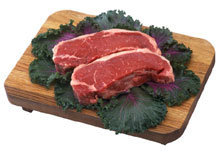 As essential as it is to eat adequate amounts of protein on a regular basis, it is important not to overdo it. Since protein cannot be stored, any excess must be broken down by the liver into urea and other nitrogen wastes, and then eliminated by the kidneys. Additional strain is placed on the liver and kidneys when protein is eaten in excess.
As essential as it is to eat adequate amounts of protein on a regular basis, it is important not to overdo it. Since protein cannot be stored, any excess must be broken down by the liver into urea and other nitrogen wastes, and then eliminated by the kidneys. Additional strain is placed on the liver and kidneys when protein is eaten in excess.
Excessive protein consumption in the form of meat makes the tissue of the body acidic, which can cause numerous health problems. It also depletes calcium stores, since calcium is needed to neutralize the acids created during the digestive process of proteins. Therefore, the more protein you eat, the more calcium you excrete. This loss of calcium can eventually lead to conditions such as osteoporosis.
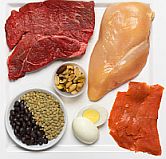 In addition, since protein can be so filling, eating too much often means less intake of vegetables, grains and other healthy foods the body needs for essential nutrients. It also can lead to dehydration, considering it takes a lot of water to eliminate extra protein. The most important thing to watch is not eating too much protein at one time since processing it can be hard on the body.
In addition, since protein can be so filling, eating too much often means less intake of vegetables, grains and other healthy foods the body needs for essential nutrients. It also can lead to dehydration, considering it takes a lot of water to eliminate extra protein. The most important thing to watch is not eating too much protein at one time since processing it can be hard on the body.
The Right Amount of Protein
The right amount of protein for any individual is based on ideal weight, activity level and gender. If a person is more active, lifts weights or is under a lot of stress, then their protein needs will be greater. Less protein is needed for a person who is more sedentary. Generally, a woman needs less protein than a man. However, a pregnant woman or nursing mother should add an additional 20-30 grams a day to her protein intake.
To calculate your protein needs according to the recommended daily allowance (RDA), take your ideal weight in pounds and divide it by 2.2 to determine your weight in kilograms. Then multiply that number by 0.8 to determine your recommended protein intake in grams. Examples of servings of a few different protein sources in grams are:
- 4 ounces of lean beef – 28 grams
- 3.5 ounces chicken breast – 30 grams
- 1 cup black beans – 15.2 grams
- ¼ cup almonds – 8 grams protein
- 1 omega 3 egg – 6 grams protein
- 2 tablespoons peanut butter – 8 grams
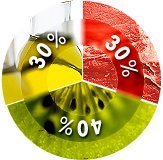 Dr. Don Colbert, in his latest book entitled “I Can Do This” Diet, recommends limiting servings of meat to a couple of times of week for weight loss. He says that portion sizes should be limited to two to six ounces for women and three to eight ounces for men of leaner cuts of meat. What is right for an individual is dependent upon their weight and activity level as well as gender.
Dr. Don Colbert, in his latest book entitled “I Can Do This” Diet, recommends limiting servings of meat to a couple of times of week for weight loss. He says that portion sizes should be limited to two to six ounces for women and three to eight ounces for men of leaner cuts of meat. What is right for an individual is dependent upon their weight and activity level as well as gender.
Most nutrition and weight loss experts agree that diets should consist of approximately 30 percent protein, 30 percent fats and 40 percent carbohydrates. Rather than tracking grams, let your focus be eating high quality protein sources and getting the right balance in your diet with each meal and snack. Regularly eating the right proportions of good quality protein will benefit your health and play a key role in enabling you to maintain a healthy weight.
Next month’s focus:
Of the three macronutrients, the one most blamed for excess weight is fat. Next month we will delve into the facts on fat and why a low-fat diet may not be your best option for weight loss or health.
Summary Points:
- In addition to comprising the building blocks of life, protein plays a primary role in health and regulating weight.
- Protein supports lean muscle mass, which is key to an active and efficient metabolism.
- Protein stimulates the production of glucagon, the hormone that turns body fat into energy.
- For optimum health, obtain protein from high-quality, natural sources.
- Over-consuming protein, especially from meat, makes the body acidic and puts a strain on the kidneys and liver.
- Roughly 30% of a person’s diet should consist of protein, eaten in the right proportions with each meal or snack.
Sources:
“I Can Do This” Diet, by Don, Colbert, M.D.
Mastering Your Metabolism, by Jillian Michaels
Ultrametabolism, by Mark Hyman, M.D.
Crack the Fat Loss Code, by Wendy Chant
Copyright © 2008-2015 Lucinda Bedogne, CNHP, CNC
Post Your Comment...
|
|
||||||||||||


